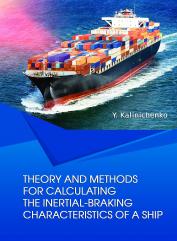THEORY AND METHODS FOR CALCULATING THE INERTIAL-BRAKING CHARACTERISTICS OF A SHIP
Keywords:
maneuvering of ships, accident rate, navigation safety, inertial-braking characteristics, full-scale tests, propeller thrust, resistance to ship movementSynopsis
One of the most serious problems of modern navigation is the accident rate that occurs due to inept or belated maneuvering of ships. As a result of accidents in the world, more than 200 ships sink every year and every fourth receives significant damage.
Full-scale tests show that the stopping distance of large-tonnage ships turn out to be much less permissible, and shipbuilders are able to significantly reduce the astern power of such ships, making them cheaper at the expense of safety.
The low accuracy of inertial-braking characteristics is mainly due to unqualified field tests. Analysis of graphs and tables based on the results of such tests show that the spread in the values of inertial-braking characteristics for ships of the same type reaches 30%, and in some cases even more. In many tables and graphs, inertial-braking characteristics are expressed in relative values and are not suitable for direct use when maneuvering a ship. Finally, even when graphical and/or tabular maneuvering information is available on the navigating bridge, it is difficult to use it when maneuvering a ship at night.
The research carried out by the author results in:
- creation of an alternative computational method for determining the inertial-braking characteristics of the ship, suitable for use on any on-board computer;
- development of an improved methodology for calculating the path and time of acceleration and braking of the ship in various ahead motion modes;
- development of a methodology for taking into account the influence of a passing and opponent current on the length of the stopping distance of the ship;
- development of methods for solving applied problems, ensuring a decrease in the accident rate of ships during maneuvering.
The obtained methods include the development of theoretical foundations, mathematical models and comparison of the calculated inertial-braking characteristics of ships with the data of a full-scale experiment. For the first time, to derive the calculated formulas for the time and stopping distance, theorems are used on the change in the momentum and kinetic energy during accelerated and decelerated motion of the ship. In the course of the study, the problems of calculating and formalizing the inertial-braking characteristics of the ship are being comprehensively solved. For the first time, the hypothesis that the nature of the change in the thrust force of the propeller during reverse can be approximated by linear equations has been substantiated and confirmed. The general results are used to calculate the inertial-braking characteristics of specific ships.
References
Ericke, W., Grossman, G. (1971). Beitrag zur Vorausberechnung Von Stoppmanovern grober X Schiffe. Hansa, Sondernim, STG, 108, 2176–2182.
Tani, H. (1970). On the Stopping Distances of Giant Vessels. Journal of Navigation, 23 (2), 196–211. doi: http://doi.org/10.1017/s0373463300038406
Iarkin, P. I. (2004). Analiz standartov IMO po manevrennym kachestvam sudov. Materialy mezhd. nauchn.- tekhn. konf. Chast 1. Odessa: ONMA.
Iarkin, P. I. (1983). Printsip normirovaniia tormoznykh kharakteristik morskikh sudov. Sudostroenie, 11.
Nebesnov, V. I. (1967). Dinamika sudovykh kompleksov. Leningrad: Sudostroenie, 296.
Voitkunskii, Ia. I., Pershits, R. Ia., Titov, I. A. (1960). Spravochnik po teorii korablia. Leningrad: Sudpromgiz, 688.
Gofman, A. D. (1988). Dvizhitelno-rulevoi kompleks i manevrirovanie sudna. Leningrad: Sudostroenie, 360.
Abkowitz, M. A. (1980). Measurement of Hydrodynamic characteristics from ship trials by system identification. SNAME Transactions, 88, 283–318
Okamoto, H., Tanaka, A., Nozawa, K., Saito, Y. (1974). Stopping abilities of ships equipped with controllable pitch propeller1. International Shipbuilding Progress, 21 (234), 40–50. doi: http://doi.org/10.3233/isp-1974-2123402
Okamoto, H., Tanaka, A., Nozawa, K., Saito, Y. (1974). Stopping abilities of ships equipped with controllable pitch propeller1. International Shipbuilding Progress, 21 (235), 53–69. doi: http://doi.org/10.3233/isp-1974-2123501
Pavlenko, V. G. (1979). Manevrennye kachestva rechnykh sudov. Moscow: Transport, 184.
Bakaev, V. G., Lavrentev, V. M. (1955). Raschet puti i vremeni razgona i tormozheniia sudna pod deistviem grebnogo vinta. Sb. TSNIIMF, 1 (1).
Nebesnov, V. I. (1961). Dinamika dvigatelia v sisteme korpus sudna-vinty-dvigateli. Leningrad: Sudpromgiz, 374.
Grechin, M. A. (1972). Manevrennye i morekhodnye kachestva tankera «Sofiia». Moscow: Sb. TSNIIMF «Tekhnicheskaia ekspluatatsiia morskogo flota», 93.
Grechin, M. A. (1973). Raschet manevrennykh kharakteristik sudna, sviazannykh s deistviem grebnogo vinta. Morekhodnye kachestva sudov. Trudy TSNIIMF, 165, 38–55.
Grechin, M. A. (1958). Raschet kharakteristik razgona i tormozheniia sudna. Sb. TSNIIMF, 15, 97–109.
Leskov, M. M., Oganov, A. M., Kurguzov, S. S. (1975). Universalnaia tablitsa ucheta inertsii sudna. Sb. TSBNTI MMF «Sudovozhdenie i sviaz», 10 (85), 75.
Demin, S. I. (1975). Tormozhenie sudov. Moscow: Transport, 81.
Solarev, N. F. (1980). Bezopasnost manevrirovaniia rechnykh sudov i sostavov. Moscow: Transport, 215.
Tani, H. (1968). The Reverse Stopping Ability of Supertankers. Journal of Navigation, 21 (2), 119–154. doi: http://doi.org/10.1017/s0373463300030290
Jaegor, H. E., Jourdain, M. (1968). The braking of the large vessels. Shipp. World and Shipbuilder, 162, 3825.
Hewins, E. P., Chase, H. J., Ruiz, A. L. (1950). The Backing power of geared – turbine – driven vessels. SNAME Transactions, 58, 261–301.
Maltsev, A. S. (2002). Manevrirovanie sudov pri raskhozhdenii. Odessa: OMTTS, 208.
Snopkova, V. I. (Ed.) (1991). Upravlenie sudnom. Moscow: Transport, 359.
Schetinina, A. I. (Ed.) (1983). Upravlenie sudnom i ego tekhnicheskaia ekspluatatsiia. Moscow: Transport, 655.
D’Arcangelo, M. (Ed.) (1957). Guide to the selection of backing power. SNAME, 84.
Hooft, J. P. (1969). The steering of a ship during the stopping manoeuvre. TNO, Report No. 114.
Norrbin, N. H. (1971). Theory and observations on the of a mathematical model for ship manoeuvring in deep and confined waters. Trans. Swedish State Shipbuilding Experimental tank, Goteborg, 68 (19), 117.
Sainsbury, J. C. (1963). Stopping the ship. Ship and Boat Builder, 34–37.
Katsman, F. M., Dorogostaiskii, D. V. (1979). Teoriia sudna i dvizhiteli. Leningrad: Sudostroenie, 280.
Voitkunskii, Ia. I., Pershits, R. Ia., Titov, I. A. (1960). Spravochnik po teorii korablia. Leningrad: Sudpromgiz, 688.
Lap, A. J. W. (1954). Diagrams for determining the resistance of single-screw ships. International Shipbuilding Progress, 1 (4), 179–193. doi: http://doi.org/10.3233/isp-1954-1403
Norrbin, N. H. (1971). Theory and observations on the of a mathematical model for ship manoeuvring in deep and confined waters. Trans. Swedish State Shipbuilding Experimental tank, Goteborg, 68 (19), 117.
Iarkin, P. I., Kalinichenko, Y. V. (2003). Opredelenie kharakteristik aktivnogo tormozheniia sudna. Alternativnii podkhod. Sudovozhdenie, 6, 159–165.
Hewins, E. P., Chase, H. J., Ruiz, A. L. (1950). The Backing power of geared – turbine – driven vessels. SNAME Transactions, 58, 261–301.
Snopkova, V. I. (Ed.) (1991). Upravlenie sudnom. Moscow: Transport, 359.
Schetinina, A. I. (Ed.) (1983). Upravlenie sudnom i ego tekhnicheskaia ekspluatatsiia. Moscow: Transport, 655.
Sainsbury, J. C. (1963). Stopping the ship. Ship and Boat Builder, 34–37.
Tani, H. (1968). The Reverse Stopping Ability of Supertankers. Journal of Navigation, 21 (2), 119–154. doi: http://doi.org/10.1017/s0373463300030290
Iarkin, P. I., Kalinichenko, Y. V. (2003). Opredelenie kharakteristik aktivnogo tormozheniia sudna. Alternativnii podkhod. Sudovozhdenie, 6, 159–165.
Kalinichenko, Y. V. (2004). Opredelenie vremeni i skorosti razgona sudna na zadnii khod. Materialy mezhdunarodnoi nauchn.-tekhn. konferentsii. Chast 1. ONMA, 153–156.
Maltsev, A. S. (2002). Manevrirovanie sudov pri raskhozhdenii. Odessa: OMTTS, 208.
Pavlenko, L. V. (2002). Manevrennye kharakteristiki krupnotonnazhnykh sudov. Sudovozhdenie, 5, 74–88.
Schetinina, A. I. (Ed.) (1983). Upravlenie sudnom i ego tekhnicheskaia ekspluatatsiia. Moscow: Transport, 655.
Snopkov, V. I. (Ed.) (1991). Upravlenie sudnom. Moscow: Transport, 359.
Motora, S. (1972). Maneuverability, state of the art. Proceedings of the International Jubilee Meeting on the occasion of the 40 th anniversary of the Netherlands Ship Model Basin, 38.
Scripture, F. R. (1966). Marine Radar Collision Avoidance System Requirements. Navigation, 13 (4), 295–301. doi: http://doi.org/10.1002/j.2161-4296.1966.tb02172.x
Kalinichenko, G., Kalinichenko, Y. (2018). Calculation of safe speed and minimally admissible distance of closing of ships during radar information usage. Technology Transfer: fundamental principles and innovative technical solutions. Tallinn, 58–60. doi: http://doi.org/10.21303/2585-6847.2018.00758
Tsurban, A. I. (1977). Opredelenie manevrennykh elementov sudna. Moscow: Transport, 126.
Kalinichenko, Y. (2017). Calculation of ship’s active braking characteristics. Technology Transfer: fundamental principles and innovative technical solutions. Tallinn, 42–44. doi: http://doi.org/10.21303/2585-6847.2017.00474
Kalinichenko, Y. V. (2017). Vdoskonalennia alhorytmiv informatsiionoho zabezpechennia manevruvannia suden. Odessa, 252. Available at: http://onma.edu.ua/wp-content/uploads/2016/09/disser_kalin.pdf









